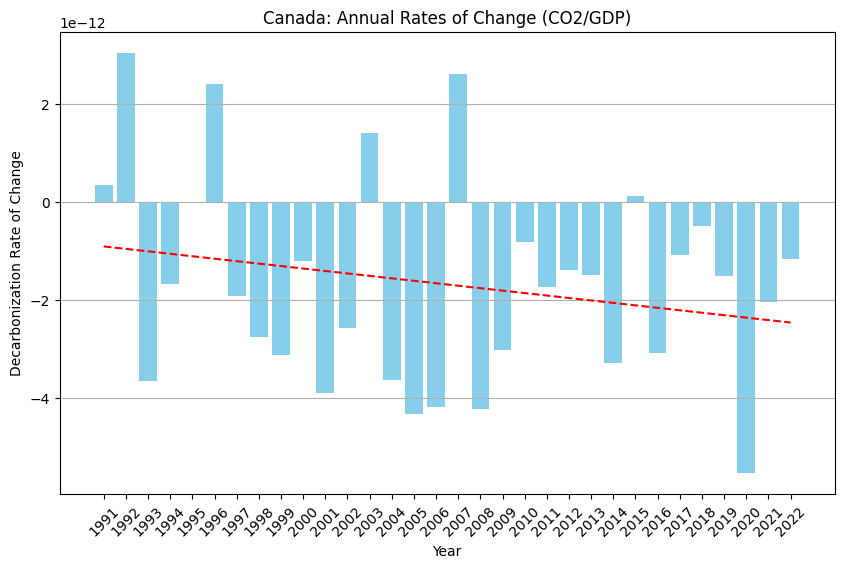Have Canada's Decarbonization Efforts Been Effective?
And some thoughts about nexts steps for The Audit
The Audit has now been active for a few months: this is post number 23. From the start I’d hoped to discover more about what you readers are looking for and how the publication can inspire positive and practical change. There’s been encouraging feedback, but I’m far from the end of my “discovery” stage, here.
As I cynically suspected, I found that I could easily churn out regular articles describing shameful examples of government waste and incompetence pretty much indefinitely. The supply of such material far outstrips demand.
But so what? Besides breeding more cynicism, how will a hundred or a thousand such articles actually fix anything? So far I’ve received exactly zero feedback from repentent and remorseful assistant deputy ministers begging for guidance in changing their errent, sinful ways. And I don’t expect that to change any time soon. So what can I change to give this publication some added practical value?
I do hope to branch out beyond the everyday fiscal and policy incompetence to explore some genuinely difficult - even insolvable - problems that are faced by various levels of government. Perhaps focusing on those might spark discussions about big-picture mission scope and improving the decision-making process.
Since I began spending time with official government datasets, there have been some surprises. Although the small-government libertarian in me isn't happy about this, I've come across some things that governments do very well. I suppose I could, from time to time, try to highlight some of those success stories.
What do you think? Where would you like to see The Audit go next?
At any rate, here’s another boring example of government policy outcomes.
Just last week, Roger A. Pielke Jr. wrote about using the “decarbonization ratio” as an interesting way of measuring progress in lowering carbon emissions.
The way Professor Pielke explains it, the ratio is a measure of how much carbon dioxide is emitted per unit of economic output, expressed in terms of tonnes of carbon dioxide per $1000 of GDP. Effectively, this ratio can help us evaluate our progress in reducing the carbon intensity of the economy.
By analyzing changes in this ratio over time, one can assess whether the world is effectively decarbonizing its economic activities, meaning whether or not it's reducing the amount of carbon dioxide emissions generated per dollar of GDP. This approach aligns economic growth with environmental sustainability by indicating how technological advancements and policy measures contribute to a less carbon-intensive economy.
You may recall how I recently used changes in extreme weather events to measure the effectiveness of government climate policies. Perhaps applying Professor Pielke’s formula specifically to Canada’s GDP and carbon emissions numbers would offer us more and better insights. So I ran the numbers and this is what came out the other end.
The graph below represents the annual, year-over-year changes to the decarbonization ratio (and not the ratio itself). Ideally, our rate of change should be growing year after year as we get better at managing both our economies and emissions outputs.
In fact, as the graph’s trend line shows, improvements are modestly speeding up:
Decarbonization does seem to be happening. And it’s possible that Canada's recent climate policies have had a positive influence on that. That’s good news for those of us would prefer environmental progress that doesn’t lead to widespread social chaos and human suffering.
If we were to narrow the graph’s scope to just the years since 2015, we’d see that the positive trend holds up (unlike Pielke’s global findings):
Here’s something else to think about. Not all nations are equally effective. Here’s what things look like in the United States where, overall, progress has been steady.






I’m glad you did this analysis for Canada. I have a couple questions/comments:
1) “Decarbonization ratio” seems like a confusing term to me. I would stick to Pielke’s usage of decarbonization = the (negative) rate of change in the carbon intensity of the economy (C/GDP) or “a reduction in the ratio of emissions to GDP”.
2) Maybe I’ve got myself turned around but isn’t a downward slope in the rate of change of emissions per unit of GDP what we’re aiming for?
It looks like the GDP measure used is nominal GDP which is influenced by inflation. Since carbon emmissions are caused by real economic activity a more accurate measure would use real GDP.